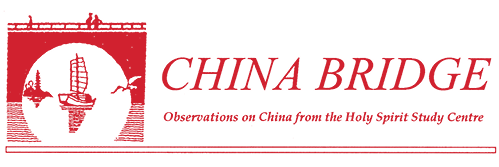
China Bridge (神州橋樑)_2011/Feb
Astrology in the bible and Chinese New Year

There are three main branches of astrology, namely western, Indian and Chinese or east Asian. The study of western astrology and the belief in it, as part of astronomy, is first found in a developed form among the ancient Babylonians and directly or indirectly, it spread to other nations. It came to Greece about the middle of the fourth century BC and reached Rome before the advent of the Christian era.
The tradition usually called Chinese astrology by westerners is, in fact, not only used by the Chinese, but has a long history in other east Asian countries such as Japan, Thailand and Vietnam.
Astrology is believed to have originated in China about the third millennium BC. Traditionally, astrology was always highly regarded in China and, indeed, Confucius is said to have treated it with respect saying, “Heaven sends down its good or evil symbols and wise men act accordingly.”
The 60-year cycle combining the five elements with the 12 animal signs of the zodiac has been documented in China since at least the time of the Shang (商) dynasty (ca. 1766 BC to 1050 BC).
Today’s astrology is a perversion of true astrology. It is in line with the type of astrology, witchcraft, soothsaying and fortune telling that God condemns. True Christian astrology and, for that matter, astrology before Christ, is ancient. Reading the stars and their interpretation was common to ancient civilisations before there was any writing.
Before the bible, people read the stars and constellations as revealing God’s plan. Actually, astrology points to intimate details of the revealing of the Messiah, Jesus Christ. Pagan and present astrology only interprets or predicts events that take place on earth and in people’s lives, many of the events are unrelated to God at all.
Here are some examples of this ancient method of the revelation of the will of God which can rightly be called Christian astrology.
Astrology refers to every 2,160 years as a new age, which is a different sign of the zodiac that comes into position to influence the earth. The bible describes events that will occur according to the signs of the astrological ages.
“Anyone who speaks against the Holy Spirit will not be forgiven, either in this age or in the ages to come” (Matthew 12:32).
“What will be the sign of your coming and of the end of the age?” (Matthew 24:3).
“Then Christ would have had to suffer many times since the creation of the world. But now he has appeared once for all at the age of the ages” (Hebrews 9:26).
Another astrological reference concerning Christianity deals with the northern solstice, which falls on December 21. It is the day of the year when the night is longest and the daytime shortest.
The ancient Egyptians noticed that on the winter solstice, the sun does not set farther south and sets at the same place on the horizon for three days. This is an astrological reference to when the sun (Son) goes down for three days (dies) and then begins to rise again (resurrection). Using the crude instruments available to them, ancient astronomers were able to detect that, by December 25 of each year, the daytime had become noticeably longer.
This date was chosen – and remains the traditional date for followers of many different religions – to celebrate the rebirth of the sun. Following the equinox, each succeeding day has slightly more sunlight than the previous day. It was seen as a promise that warmth would return once more to the earth.
“How clearly the sky reveals God’s glory! How plainly it shows what he has done! Each day announces it to the following day; each night repeats it to the next. No speech or words are used, no sound is heard; yet their voice goes out to all the world and is heard to the ends of the earth” (Psalm 19:1-4).
“There shall be signs in the sun, the moon and the stars” Jesus Christ (Luke 21:25).
“And God said, ‘Let there be lights in the expanse of the sky to separate the day from the night, and let them serve as signs to mark seasons, days and years, and let them be lights in the expanse of the sky to give light on the earth’ And it was so” (Genesis 1:14-15).
One of the great astrological stories in the bible is that of the Star of Bethlehem. It is written that it was a sign from God signalling the birth of the Messiah into the world. The three Magi, Persian astrologer-kings, determined the time of this birth by the position of this star.
In 1600, Johannes Kepler hypothesised that this star was actually a conjunction of Jupiter and Saturn. Confirmed by modern astrology, this symbolism ties in with the prophecies of that era concerning a Messiah amongst the Jews. The conjunctions occurred at the end of Pisces (the fish, the Church age), ruled by Jupiter, which is the planet of kings. Saturn is the planet that rules the Jews, thereby giving us the king of the Jews. This was an infrequent conjunction and it occurred in the year 7 BC.
Jesus was not born on December 25 of 1 BC, as worked out by the Scythian monastic scholar, Dionysius Exiguus in 525 AD. King Herod, of whom the magi inquired about the birth, died in 4 BC. For other reasons, the birth is fairly firmly dated to between 5 and 4 BC. If the shepherds were “abiding with their flocks by night” the birth did not take place in December.
When the Magi say “…we have seen his star in the east…” they would have been referring to the helical rising of a star or planet, that is, when it is newly visible in the morning sky rising ahead of the sun. Jupiter had its helical rising on April 17 of 6 BC in Aries. Jesus was born under the end of the age of Aries (the lamb – this may explain why he called himself the Lamb of God).
The astronomer, Michael Molnar, who did a study about the star of the Magi, concludes that in terms of astrological import, this day is absolutely unique for hundreds of years and makes a strong case that he has indeed found the origin of the curious story in Matthew. He feels the star must have been based on what the magi would have considered as important. As astrologers, they would take the star to be a horoscope indication of the birth of an extremely great king in Judea.
Christian scholars have expended considerable ingenuity in providing scientific glosses for the scriptural account of the star that shone above Bethlehem at the time of Jesus’ birth. Molnar disputes such explanations precisely because they derive from a modern perspective far removed from the outlook of ancient stargazers, who eagerly scanned the heavens for signs of the Messiah’s birth.
Ancient texts show conclusively that no portent would have excited greater expectations of a divine birth in Judea than a lunar occultation of Jupiter in the constellation Aries. Because sophisticated computer calculations reveal that such an eclipse did occur on April 17 in the year 6 BC, he fixes this as the celestial event that signalled the Christ-child’s birth.
This assertion does require pushing Christ’s birth back two years earlier than the commonly accepted 4 BC, but evidence gleaned from early Roman and Jewish sources makes an earlier Nativity plausible. The uncanny fit of all the ancient and modern pieces of this puzzle makes for a highly persuasive argument” (Bryce Christensen).
Modern astronomers tend to be instantly dismissive of anything having to do with astrology, even to the extent of neglecting its proper application to a historical problem such as the star of the Magi. Astrology, like it or not, is an important part of the history of human thought and of the history of astronomy itself.
All of the above leads us to the annual, moveable celebration of the Chinese New Year!
Chinese people all over the world will be celebrating with family and friends a tradition has been observed for about 5,000 years!
The ancient Chinese calendar on which the Chinese New Year is based, functioned as a religious, dynastic and social guide. It is a complex timepiece and its parameters are set according to the lunar phases as well as the solar solstices and equinoxes.
Yin (陰) and Yang (陽), the opposing but complementary principles that make up a harmonious world, also rule the calendar, as does the Chinese zodiac, the cycle of 12 stations or signs along the apparent path of the sun through the cosmos. Each new year is marked by the characteristics of one of the 12 zodiac animals: the rat, ox, tiger, rabbit, dragon, snake, horse, sheep, monkey, rooster, dog and pig.
This year we celebrate the Year of the Rabbit (兔). There will be many things written and talked about the rabbit – all its good and not-so-good characteristics and all done in good humour. For the most part, in modern China and Hong Kong, people keep to the many traditions, but do not believe in the superstitions of old.
This is a significant family festival and Christians in China and around the world can and should enjoy this festival. Just like the other feasts we have just celebrated, such as Christmas, the star of the Magi, and the northern solstice, we are on a journey of time fixed by the sun, moon and stars.
As Christians we have no need of superstitions as we are guided by the words of Jesus, “I am the way, the truth and the life… Do not be afraid… I am with you always to the close of the age” (John 14:6, Matthew 28:20).
Happy Chinese New Year to all from the staff of HSSC.


 ENG
ENG